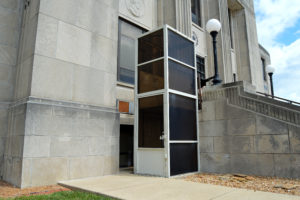
Its All About the Tools
August 23, 2018
Elevator Flood
September 20, 2018It’s a Chairlift not a Freight Elevator

Fantastic news for the elevator industry! Another chairlift has broken down and the building owner is shopping for an elevator as a replacement. That is the last sentence a building owner wants to read, however it is an all too familiar occurrence. The most common reason for failure is that the wheelchair lift is being used for everything other than wheelchairs and being used way too often under stress. Recently one building manager told me that he has heard that employees call wheelchair lifts “the freight elevator”.
That pretty much sums up the issue.
See, most wheelchair lifts and LULA (limited use, limited application) elevators use a cantilever system where the support for the load juts out from just one-side of the hoistway under the platform or car. Ultimately, the further out the load is shifted from that side, the more likely damage can be done, especially if repeated often.
Due to this design and other factors, the lifting capacity for most wheelchair lifts is around 500 lb to 750 lb and often they are restricted by law or specs to a wheelchair, the occupant and one attendant only. Also, if you are moving one item in a LULA or other elevator, code restricts use to 25% of the total weight capacity. So, a baby grand piano (or any piano) is too heavy, a fridge – too much, a cast iron bath tub – a bit of a strain. Just because you can fit something in it or on it, doesn’t mean that you should try to move it. Keep this in mind too; just because the lift moves up and down, doesn’t mean that’s OK. It may well be harming your lift and the further away the load is from the side with the support, the more harm you could do.
Case Study
One particular case that illustrates this was a lift installed for an old building being used for events in a small town. To better accommodate guests with disabilities, they wanted a lift for vertical transportation. To save money, they went with a LULA (Limited Use Limited Application) lift. They thought that people with disabilities would use it occasionally. Limited use, right? But, after multiple return trips for repairs and frequent breakdowns, a video camera was placed inside the car to figure out the problem. Low and behold, the cause was discovered.
The video revealed the actual use was not limited in the least and was more appropriate for a freight elevator. We watched the video of a typical Saturday night as heavy sound and lighting equipment, chairs, food carts and caterers avoided the steps and used the little LULA that could. So much for limited use and application. This was no minimally used elevator for people in wheelchairs, but a lift used by many for convenience, to avoid trudging up a flight of steps and carrying lots of heavy things that no one wanted to lug. In one day, there were over 100 trips logged, many with too much weight.
Ultimately, the owner had only 2 options: limit the use to disabled people only, or to have purchased a beefier, commercial elevator. The first is difficult to implement and police, and can lead to user dissatisfaction. So the better option would have been to install a commercial elevator in the first place.
Ways to Avoid Problems
To avoid a similar fate, here are steps to take when choosing the right mode of vertical transport:
→ Be realistic about the use. Know that unless the elevator is supervised, people will use it for nearly anything.
→ Pick an elevator that meets the needs of the use. This may mean a simple chairlift, LULA, commercial passenger or freight elevator. Keep in mind that there are several capacities for LULAs and all elevators or lifts. Pick an elevator that fits your needs, and if you aren’t sure, ask a professional.
→ Listen to experts. Don’t be afraid to ask questions regarding use and suitability of the particular model you are looking at. Call several companies that install elevators, not just sales representatives for LULA companies.
→ Get to know your code or ask. Depending on the building, location, and other factors you may be required to have something more than a wheelchair lift or LULA.
→ Shop carefully. There is more than one elevator company in the world and several lift companies. Look before you buy.
→ Find the right one for you with a certified installer you can trust. This is the team that will be installing and maintaining; make sure they are qualified.
If you have a lift or LULA and the problems are starting to pile up, think about your use. Consider that use may be outside of the abilities of the lift and limitations. Consider an upgrade if one is needed or track usage more closely. The bottom line is that LULA and chairlifts means limits and you need to be clear-minded about your needs, so you can get the right vertical transportation to start with. That way, you can avoid a replacement that drives up costs, needs a multitude of repairs, and the inconvenience of unnecessary shut downs along the way.



